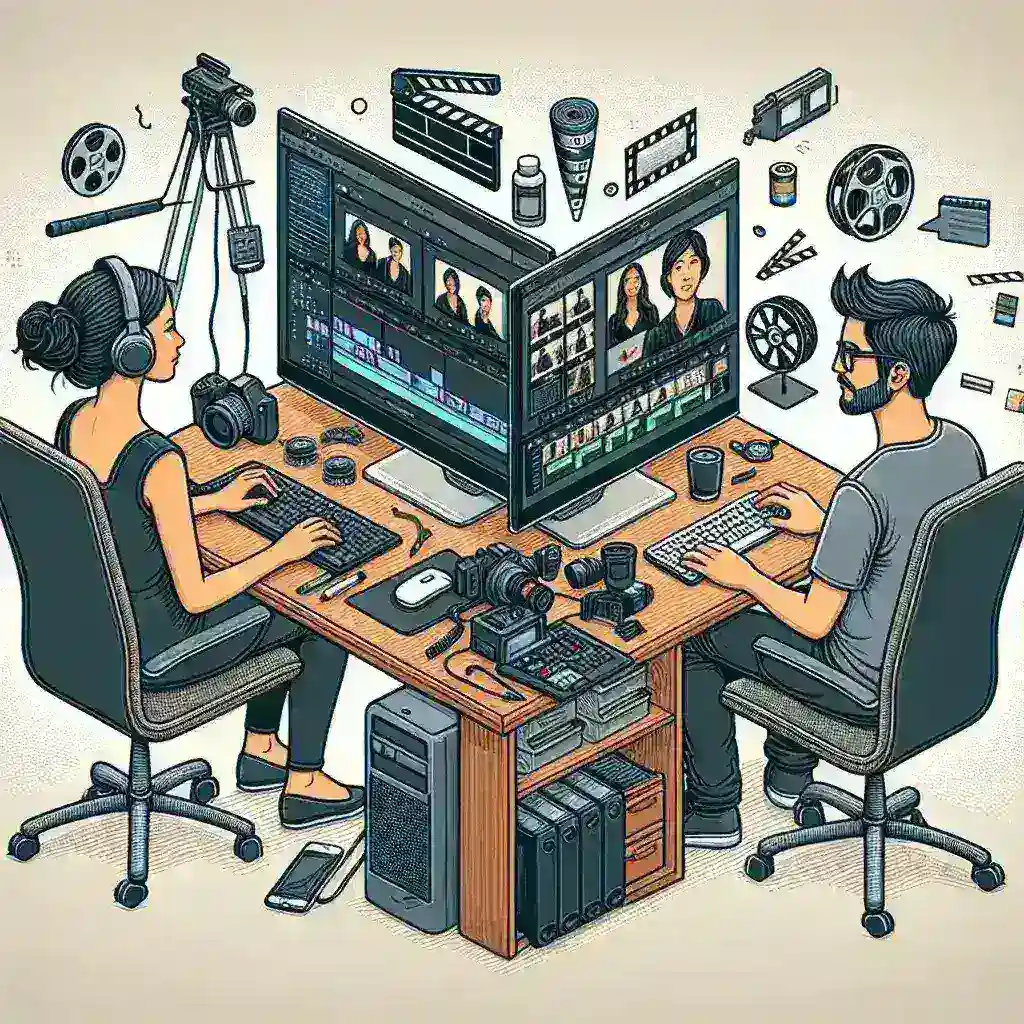In today’s fast-paced digital landscape, content creators and video professionals face an ever-increasing demand for high-quality visual content. The pressure to deliver compelling videos quickly has led to the widespread adoption of motion templates—pre-designed animated sequences that can dramatically accelerate the editing process while maintaining professional standards.
Understanding Motion Templates: The Foundation of Efficient Editing
Motion templates represent a paradigm shift in video production methodology. These pre-built animated sequences contain customizable elements such as text placeholders, image slots, and adjustable parameters that allow editors to create sophisticated animations without starting from scratch. Think of them as the video editing equivalent of architectural blueprints—providing structure while allowing for creative customization.
The evolution of motion templates can be traced back to the early 2000s when video editing software began incorporating template functionality. However, the modern iteration has transformed into a sophisticated ecosystem of professionally designed assets that cater to virtually every industry and creative need.
The Strategic Advantages of Template-Based Editing
From a professional perspective, motion templates offer several compelling advantages that extend beyond mere time savings. Consistency emerges as perhaps the most significant benefit, as templates ensure brand coherence across multiple projects and team members. This standardization proves invaluable for agencies managing multiple clients or companies maintaining strict brand guidelines.
Cost efficiency represents another crucial factor. By utilizing templates, organizations can reduce the need for specialized motion graphics artists on every project, allowing existing team members to produce professional-quality animations. This democratization of motion graphics capabilities has revolutionized how smaller studios and independent creators approach video production.
Quality Assurance Through Professional Design
Motion templates typically originate from experienced motion graphics designers who understand the nuances of effective animation. This means that even novice editors can access professionally crafted animations that would otherwise require years of experience to create independently.
Implementing Motion Templates: A Step-by-Step Approach
The successful integration of motion templates into your workflow requires a systematic approach that considers both technical and creative factors.
Template Selection and Evaluation
Begin by establishing clear criteria for template selection. Consider factors such as resolution compatibility, software requirements, and customization flexibility. High-quality templates should offer multiple customization options while maintaining their visual integrity across different applications.
When evaluating templates, pay particular attention to the included assets. Premium templates often include custom fonts, sound effects, and additional graphic elements that enhance the overall production value.
Technical Integration Process
The integration process varies depending on your chosen editing platform, but several universal principles apply. Always create backup copies of original template files before making modifications. This practice ensures you can return to the original state if customization attempts encounter issues.
Organize your template library systematically, creating categories based on project types, industries, or visual styles. This organizational approach significantly reduces search time and improves workflow efficiency during active projects.
Advanced Customization Techniques
While templates provide excellent starting points, the ability to customize them effectively separates amateur implementations from professional applications. Understanding the underlying structure of motion templates enables more sophisticated modifications that align with specific project requirements.
Color Palette Adaptation
Most professional templates utilize master color controls that allow for comprehensive palette adjustments. However, advanced users can delve deeper into individual layer properties to create more nuanced color schemes that perfectly match brand requirements.
Consider the psychological impact of color choices when customizing templates. Research indicates that color selection can influence viewer engagement by up to 80%, making this aspect of customization particularly crucial for marketing-focused content.
Typography and Text Integration
Text integration represents one of the most visible customization elements in motion templates. Beyond simple text replacement, consider factors such as font pairing, hierarchy establishment, and readability optimization. Professional templates often include multiple text layers with varying weights and styles, allowing for sophisticated typographic compositions.
Industry-Specific Applications and Case Studies
The versatility of motion templates becomes apparent when examining their applications across different industries. Each sector has developed specific template categories that address unique communication needs and aesthetic preferences.
Corporate Communications
In corporate environments, motion templates facilitate the creation of training materials, presentation graphics, and internal communication videos. The standardization offered by templates ensures message consistency across different departments and geographical locations.
A multinational technology company recently reported a 65% reduction in video production time after implementing a comprehensive template system for their global training programs. This efficiency gain allowed their content team to focus on strategic initiatives rather than repetitive design tasks.
Social Media Marketing
Social media platforms have unique requirements regarding aspect ratios, duration limits, and engagement optimization. Specialized motion templates designed for platforms like Instagram, TikTok, and LinkedIn incorporate these platform-specific considerations while maintaining visual appeal.
Marketing agencies increasingly rely on template libraries to manage multiple client campaigns simultaneously. The ability to quickly adapt templates for different brands while maintaining campaign cohesiveness has become a competitive advantage in the fast-paced social media landscape.
Workflow Optimization Strategies
Maximizing the benefits of motion templates requires strategic workflow planning that considers both individual and team productivity factors.
Batch Processing Techniques
Experienced editors often employ batch processing methods when working with template-based projects. This approach involves preparing all customization elements—such as logos, text content, and brand colors—before beginning the template integration process. This preparation significantly reduces the time required for individual project completion.
Quality Control and Review Processes
Establish standardized review processes that account for the unique characteristics of template-based projects. While templates provide professional foundations, careful attention to customization details remains essential for maintaining quality standards.
Consider implementing a peer review system where team members evaluate template customizations for brand compliance and technical quality. This collaborative approach helps identify potential issues before final delivery.
Future Trends and Technological Developments
The motion template landscape continues evolving as technology advances and user expectations change. Artificial intelligence integration represents one of the most promising developments, with emerging tools offering automated template customization based on brand guidelines and content analysis.
Machine learning algorithms are beginning to analyze successful template implementations to suggest optimal customization approaches for specific industries or content types. This technological advancement promises to further streamline the template utilization process while maintaining creative flexibility.
Interactive Template Development
The emergence of interactive video content has sparked development of specialized motion templates that incorporate user engagement elements. These advanced templates enable creators to produce interactive experiences without extensive programming knowledge.
Measuring Success and ROI
Quantifying the impact of motion template implementation requires establishing relevant metrics that align with organizational objectives. Common success indicators include production time reduction, cost per finished minute, and client satisfaction scores.
Many organizations report production time reductions of 40-70% after implementing comprehensive template systems. However, the most significant long-term benefit often emerges in the form of increased creative capacity, as teams can allocate more time to strategic and innovative projects.
Common Pitfalls and How to Avoid Them
Despite their numerous advantages, motion templates can present challenges when implemented incorrectly. Over-reliance on templates without sufficient customization can result in generic-looking content that fails to differentiate brands effectively.
Maintain a balance between efficiency and originality by using templates as foundations rather than final solutions. Invest time in understanding template structure to enable more sophisticated customizations that align with specific project requirements.
Additionally, avoid the temptation to use overly complex templates for simple projects. The most effective template implementations match complexity levels with project requirements, ensuring optimal resource utilization.
Building Your Template Library
Developing a comprehensive template library requires strategic planning and ongoing curation. Start by identifying the most common project types within your organization and prioritize template acquisition accordingly.
Consider both commercial and custom template options. While commercial templates offer immediate availability and professional quality, custom templates provide unique branding opportunities and perfect alignment with organizational needs.
Regular library maintenance ensures continued relevance and technical compatibility. Establish scheduled reviews to evaluate template performance and identify opportunities for library expansion or refinement.
The strategic implementation of motion templates represents a transformative approach to video production that balances efficiency with creative excellence. By understanding the principles outlined in this guide and adapting them to specific organizational needs, content creators can achieve remarkable improvements in both productivity and output quality. The future of video editing increasingly favors those who can leverage these powerful tools while maintaining the creative vision that distinguishes exceptional content from merely adequate productions.




